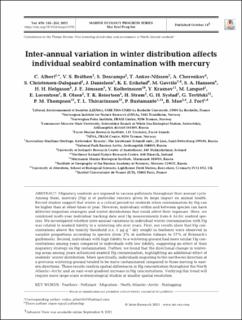Inter-annual variation in winter distribution affects individual seabird contamination with mercury
Albert, Céline; Bråthen, Vegard Sandøy; Descamps, Sebastien; Anker-Nilssen, Tycho; Cherenkov, A.; Christensen-Dalsgaard, Signe; Danielsen, Johannis; Erikstad, Kjell E.; Gavrilo, Maria; Hanssen, Sveinn Are; Helgason, Halfdan Helgi; Jonsson, Jón Einar; Kolbeinsson, Yann; Krasnov, Yuri V.; Langset, Magdalene; Lorentzen, Erlend; Olsen, Bergur; Reiertsen, Tone Kristin; Strøm, Hallvard; Systad, Geir Helge Rødli; Tertitski, G.; Thompson, P.M; Thórarinsson, Torkell Lindberg; Bustamante, P.; Moe, Børge; Fort, Jérôme
Peer reviewed, Journal article
Published version

View/
Date
2021Metadata
Show full item recordCollections
- Publikasjoner fra CRIStin - NINA [2364]
- Scientific publications [1392]
Abstract
Migratory seabirds are exposed to various pollutants throughout their annual cycle. Among them, mercury (Hg) is of particular concern given its large impact on animal health. Recent studies suggest that winter is a critical period for seabirds when contamination by Hg can be higher than at other times of year. However, individuals within and between species can have different migration strategies and winter distributions that could affect their exposure. Here, we combined multi-year individual tracking data and Hg measurements from 6 Arctic seabird species. We investigated whether inter-annual variations in individual winter contamination with Hg was related to seabird fidelity to a wintering site over years. First, our results show that Hg concentrations above the toxicity threshold (i.e. 5 µg g-1 dry weight in feathers) were observed in variable proportions according to species (from 2% of northern fulmars to 37% of Brünnich’s guillemots). Second, individuals with high fidelity to a wintering ground had more similar Hg concentrations among years compared to individuals with low fidelity, suggesting an effect of their migratory strategy on Hg contamination. Further, we found that the directional change in wintering areas among years influenced seabird Hg contamination, highlighting an additional effect of seabirds’ winter distribution. More specifically, individuals migrating to the northwest direction of a previous wintering ground tended to be more contaminated compared to those moving to eastern directions. These results confirm spatial differences in Hg concentration throughout the North Atlantic-Arctic and an east-west gradient increase in Hg concentrations. Verifying this trend will require more large-scale ecotoxicological studies at smaller spatial resolution.
